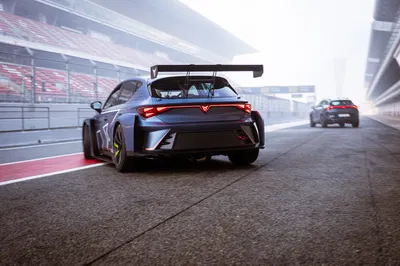What It’s Like To Drive A Real Race Car For The First Time

I have never driven a real, purpose-built race car. Sure, this job allows you plenty of opportunities to take sports cars onto tracks and in one case, had behind the wheel of a lightly-reworked Defender on a wet Welsh rally stage. But a proper, ground-up race car? So far, that has evaded me.
Like many of us, my childhood consisted of damaging my retinas playing Gran Turismo 4 on a CRT TV, and my adulthood has largely consisted of me doing the same on a sim rig funded with adult money. I’ve watched race cars, I’ve played with pretend ones but so far, the chance to experience a real one has eluded me.
That is, until today (well, not *today* as this has been written after the fact, but you get the point) and the reason for being at the Circuit de Catalunya.

You probably know it best as the home of the Spanish Grand Prix but, for those surrounding Catalonia, it’s the heartbeat of Spanish motorsport. Just 30 minutes up the road is the HQ of its most local car manufacturer, Seat, and its Cupra Racing division.
It’s there where a small handful of bodyshells for the in-production Cupra Leon are yanked off the mass production line, before they get the chance to be road cars, and then whisked away to a small corner of the factory to be fully race-prepped. Here, each becomes a Cupra VZ TCR.
First, an FIA-homologated roll cage is welded in place and a set of air jacks are fitted that’ll allow the car to suspend itself in pit stops. Beyond that, the dashboard trim from the road car goes in place although instead of comfy sports seats, two fixed buckets are shoehorned in along with an MPI steering wheel and pared-back Ecumaster LCD display sitting behind that.

Under the bonnet sits the familiar EA888 2.0-litre turbocharged four-pot engine albeit modified to take the demands of motorsport. That’ll send about 335bhp to the front wheels, with the road-going DSG ditched in favour of a six-speed sequential gearbox. You have a choice of a Sadev or Hewland-supplied unit – both are pretty similar in design, with Cupra’s head of racing, Xavi Serra, telling us that customers usually pick depending on sponsorship.
Some suspension components are retained from the Cupra road cars as they’re deemed worthy, although adjustable Ohlins shocks are fitted on all four corners. Stopping the VZ TCR is a set of carbon ceramic brakes – six pistons up front, two at the rear.
As for the bodywork beyond the shell itself, all that remains of the road car are the lights, doors and a massacred version of the bonnet. All those extended bits of aero are all functional, purpose-built carbon fibre pieces.

The final product is a car homologated for the TCR ruleset, as the name figures. This is a popular category used in everything from amateur regional series through to global championships like the FIA World Touring Car Cup. Some examples end up as far as China, a few have landed in America for the Michelin Pilot Challenge and many stay within Europe.
One has found its way into the pit lane of the Circuit de Catalunya on the least Spanish of mornings – it’s a bit chilly, a bit foggy and ever so slightly damp. Perfect conditions, then, to be sampling your first slick tyre-equipped race car.
I’m set to be first on track of the small media rotation at the circuit, the pressure of which isn’t helped by a delay because of the conditions. Cupra factory driver Jordi Gene says there’s simply too little visibility – an opinion I’ll happily trust given an extensive career which included a class win at the 2001 24 Hours of Le Mans.

It does give me a brief bit of time to familiarise myself with the machinery in front. Jordi tells me the trickiest bit will be the ceramic clutch of the sequential gearbox, which has “around 1cm of bite point at best”. Though the car does allow for clutchless flat shifting once you’re at speed, you do need it to pull out of the garage.
Race suit and helmet on, it’s time to jump into the cockpit. Although looking in from the outside made it seem spacious, it’s anything but once you’re in the fixed seat. There’s little room to manoeuvre my head with the crash helmet and attached HANS device, the steering wheel is close to my chest and just above my tightly-packed knees. I can, just about, see out of the windscreen at least. And to what felt like 500 pairs of eyes staring at me as I geared up to leave the garage.
I’ve managed to fire the car up, so that’s the first part successfully done. Before I even get a chance to process that moment properly, the air jacks have been released and the tyres on the ground. It’s time to get going.

There’s only one thought racing through my head as I begin to lift my foot off the clutch. “Don’t stall, don’t stall, don’t stall”, consciously aware of how many people are watching this moment — many of them responsible for putting the car together.
A gentle lift and a dab of throttle to keep it going (accompanied by a wonderful, cat-less burble), and success, I’m moving down the pit lane with the engine still running. The next thought, as I experience the sequential jolt from 1st to 2nd, is “holy f***ing s**t.” I’m driving a real race car.
Initially, things are a little slow. Ahead of me on track is Jordi Gene in a Cupra Formentor, serving as a point of reference as we navigate the current slippy surface of the Grand Prix circuit. I don’t come out of third for the first half of the lap, slowly easing my way into the experience. The steering feels monumentally heavy and the whine of the sequential is visceral. This feels little more than an installation lap, but the sensations are very real.

Our second lap of the circuit sees the pace pick up. Jordi begins to push his car, equipped with road tyres and four-wheel drive, harder. I struggle to keep up through the first section, partly because I’m now realising the Circuit de Catalunya has a lot more elevation than years of sim racing would suggest, but partly as I struggle to put my foot down in the conditions. The surface is still slippery, the tyres are cold and my (lack of) skill is not really in tune with the absence of traction control.
It doesn’t take too long for the approachability of the VZ TCR to begin to show, though. I can feel the surface beginning to grip up coming into the fourth corner of the circuit, a shift down to second on entry and up through to fourth on exit ignite some confidence in me as a start to get the throttle down a little more. I’m closing in on Jordi, and wondering why we’re not going faster.
I’m pretty quickly knocked down a peg. Exiting the next left-hander and approaching the chicane at the midpoint of the track, I give it my first real bury of the throttle – only to feel the wheels spin ferociously, the EA888 smash the limiter and strip of LEDs in front of me flash purple.

There’s still very little grip, and my ham-fisted approach isn’t going to work – something that’s immediately evident as Jordi gets sideways through the chicane.
As conditions begin to gently improve, so does my confidence with the car. Each turn begins to feel a little grippier, I find I’m able to be a little more aggressive on the throttle as I learn to tame it. Corner exit speeds increase, braking gets a touch later as those utterly brilliant brakes begin to showcase their talents, and everything starts to come into sync. We even find fifth gear without a slip of the front axle at one stage.
At this exact moment, had you told me I’d be about to go out for a qualifying lap for a weekend in TCR Spain, I could’ve convinced myself of at least keeping on the tail end of the pack – even though that clearly isn’t true. The car feels approachable and, though its limits are well beyond mine, the confidence it allows you to find in yourself is impressive.

And then, like that, it’s all over. After what I think are six or seven laps, it’s time to come into the pits. Reality shutters itself on my faux racing career, my time in the car is over. I jump out, adrenaline racing, desperate for it to continue. As sad as I am it’s over, the ecstasy of experiencing it is something that will never leave me.
Those brief few laps helped me to understand why TCR has become such a popular form of racing. For the price of less than a new Porsche 911 GT3 at around £110,000, here’s a bonafide race car that – with a little bit of practice – is far more approachable than the aura it oozes suggests. Why anyone with the means wouldn’t give it a go escapes me.

Now, if anyone needs a driver for hire, I’ve won five races on iRacing. Just saying.















Comments
No comments found.